DEVELOPMENT
Kotmale hydropower to national grid this month
 Shirajiv Sirimane in Kotmale Shirajiv Sirimane in Kotmale
The Upper Kotmale Hydropower Plant (UKHP) will go down in the history
of Sri Lanka as one of the most time consuming power projects to be ever
completed.
Politics controversies, environmental issues, resettlement and
funding marred this project since it was discussed way back in the
1960’s when UNDP initially identified its potential.
|
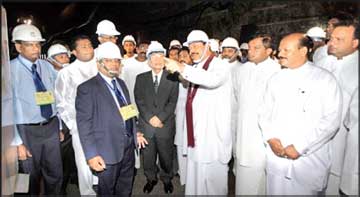
President Mahinda Rajapaksa inspecting the progress |
Several political leaders shunned this project since they thought it
was too hot to handle and it would have negative impacts for their
reelection due to its controversy.
Since Sri Lankans are paying the highest electricity bill in the
region and are heavily dependent of thermal power a cheap energy source
is a crying need. It was due to this factor that the government decided
to review this project and after almost half a century since the first
day it was identified in the Mahaweli Master Plan subsequent to a UNDP
and FAO Study.
History
The Upper Kotmale Hydropower Project (UKHP) was conceived with the
preparation of a master plan for hydroelectric development in the
Mahaweli Basin in 1968. The concepts in the master plan were further
studied in 1985-1987 when the Japanese government funded a feasibility
study to examine hydropower options in the upper reaches of Kotmale Oya
(Stream). Five sites and eight alternative development schemes were
examined in the feasibility study and the report concluded that the
development of two sites were technically and economically feasible. The
two sites were a reservoir type development at Caledonia and a run of
river project at Talawakelle. The project at Caledonia involved the
displacement of 2700 families and inundation of large area of tea land.
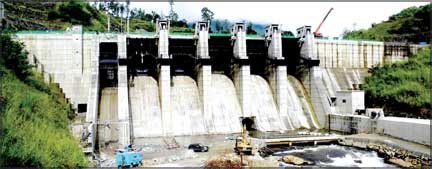
The Japanese government then provided further funding for the
Engineering Service Study, which included the review of the feasibility
study, selection of the optimal development plan, the development of the
detailed design and preparation of Tender Documents and an Environmental
Impact Assessment Report (EIAR). The EIAR was issued in September 1994.
The Final Design Report was completed in March 1995. The Environmental
Impact Assessment identified key issues associated with the UKHP such
as, impacts on waterfall aesthetics due to stream flow reductions,
social impacts due to resettlement of affected people, possible effects
on ground water due to tunnelling, impacts due to de-watering of streams
on down stream water uses and impacts on biodiversity.
Further detailed studies on alternatives were completed in 1996 and
the Forestry and Environment Ministry Secretary granted approval for the
project under the National Environment Act in July 1998 subject to
strict adoption of proposed mitigatory measures to minimise possible
environmental impacts, which included the development of a watershed
management plan, maintenance of daytime flows over the waterfalls,
monitoring of groundwater levels, an assessment of biodiversity,
management of tunnel waste and a resettlement programme.
|
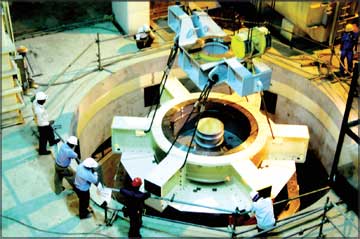
One of the generators |
This decision was challenged in the Court of Appeal in October 1998.
The Forestry and Environment Ministry Secretary gave final order in
March 2000, subsequent to the settlement of the appeal. The government
secured financial support in March 2002 from the Japanese government to
implement the project, signing of Loan Agreement in 2002 and soon it
would add the first 75 MW to the National Power Grid under its first
phase.
Project funding
The Upper Kotmale Hydropower Project is funded by the Japanese
government on an Overseas Development Assistance (ODA) loan executed
between the two governments on March 28, 2002. The loan is extended to
Sri Lanka by Japan Bank for International Cooperation (JBIC), Loan
Agreement No. SL - P74. The details of the loan are as follows. JBIC
Provides Special Yen (ODA) Loan of 33,265 million yen to Sri Lanka to
Support Stable Power Supply.
|
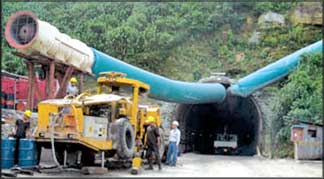
Entrance to the tunnel |
The Japan Bank for International Cooperation (JBIC; Governor: Kyosuke
Shinozawa) signed a loan agreement with the Democratic Socialist
Republic of Sri Lanka for a total loan of up to 33,265 million yen to be
used for the Upper Kotmale Hydropower Project being implemented by the
Ceylon Electricity Board.
Benefits
When completed Upper Kotmale Hydro Electricity Project which was
launched in 2006 is expected to produce 409 million units of electricity
annually. The UKHP located in the Nuwara Eliya district will be using
the water flowing from the Kotmale Oya, a branch of the Mahaweli River
and there is an assurance that the waterfalls around the area would not
dry up. Prior to commencement of construction activities in 2003, a
Comprehensive Environmental Management Plan (EMP) was prepared. This EMP
served to provide supporting information to the tender process so
ensuring that the environmental responsibilities of the contractors are
known from the beginning.
|
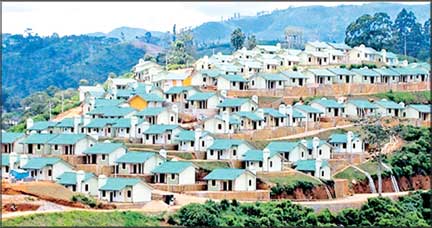
A resettled village |
The water of the Kotmale Oya will be diverted from the head pond
through the intake, from which the water enters into the headrace tunnel
(about 13 km long). The headrace tunnel conveys the water to the
powerhouse cavern, through the inclined penstock tunnel, where two
Francis turbine units will be installed.
Nearly 500 families were relocated and they have all beeing resettled
with better living conditions in new homes. Housing and other
infrastructure facilities provided for them are of very high standard. A
majority of the 495 displaced families belong to the plantation
community. Many of them were living in tin-roofed line rooms which had
one verandah and a room with no separate kitchen or bathroom facility,
forced to use one bathroom by several families. The Project has also
constructed three new Kovils, and two Christian Churches to replace
those affected by the project acquisition.
Giving these villages a new lifestyle too was another indirect
benefit from the project. Talawakelle area will also be developed as a
tourism zone, with St Clair Falls being the main attraction. A viewing
deck too is to being constructed.
The Upper Kotmale Project will provide five percent of country’s
power requirement annually providing 409 GW hours of electricity.
The project will save Rs 8 billion per year. It has no negative
impact on the environment.
[email protected]
|



